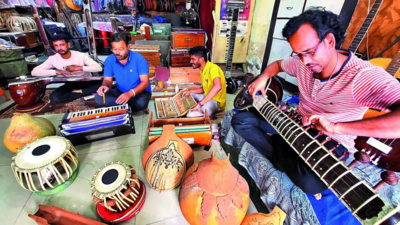The sitars of Miraj still sing. They resonate with the same depth of sound that once captivated the world through Pandit Ravi Shankar’s fingers, enchanted by Vilayat Khan’s mastery, and found an unexpected champion in George Harrison’s “Norwegian Wood”.. For now, the chisels still strike, the polish still gleams, and the strings still hum. But how much longer?
The artisans of this small city in Maharashtra’s Sangli district have breathed life into the sitar for 300 years. Today, these same hands, calloused by generations of craftsmanship, struggle to hold on to a tradition that is more inheritance than profession.
Inside the timeworn workshops in the narrow alleys of Miraj, the artisans stand at a crossroads. While the craft wavers at home, Miraj’s sitars are finding a market across the oceans. In US, Germany, and UK, musicians cherish the handcrafted instruments.
The demand for these instruments is vast — greater than ever, in fact — but the hands that craft them are growing fewer. Where once thousands laboured, only a few hundred remain.
Mohsin Mirajkar, a seventh-generation sitar maker, knows this struggle intimately. At 43, he has dedicated his life to carving, stringing, and tuning the instrument that defines his family’s legacy. Yet, he watches helplessly as younger generations turn away.“The effort it takes to make a sitar is immense,” he said. “With less effort, they can earn more in IT or engineering. The demand is huge, but we can’t even meet 25% of it.”
The irony is stark. While the world craves the authentic voice of Miraj’s sitars, the very hands that shape them are forced to consider a future without them.
“During the pandemic, only doctors and essential workers were in demand,” said Mohammed Saeem Shikalgar, a young sitar maker, who balances the art with his medical studies. “I love making sitars, but I needed a backup. If this tradition fades, I will have something to fall back on.”
To the untrained eye, a sitar might seem like just another instrument, its shape familiar, its sound enchanting but distant.
Yet, behind its curved frame lies a labour of profound patience.
It begins with a kaddu (gourd) — immersed in water, softened, and then dried until the moisture evaporates, leaving behind a hard ened shell. This humble vegetable is carved and shaped into a hollow body, its curves sculpted with an understanding that is more instinct than technique.
Craftsman Imran Salim described the process: “The polishing, the carving, the bridge, the turning pegs… everything has to be perfect. Each sitar takes about 20 to 25 days. You can’t rush it. It must be allowed to find its own voice.”
But time, the very thing these artisans honour, is now their greatest adversary. The rise of mass-produced sitars — factory-made imitations that lack the warmth of handmade ones — has only added to their woes.
Miarj’s fame was built upon its musical heritage, attracting luminaries like Pandit Bhimsen Joshi, Pandit Venkatesh Kumar, Ustad Rashid Khan, and sitar virtuosos Shujaat Khan and Ustad Shahid Parvez Khan. Even Hridaynath Mangeshkar turned to Miraj for instruments that carried not just notes but soul.
The city’s sitars still travel across borders, finding homes in concert halls, in the hands of maestros, in the quiet corners of music lovers who understand their worth. Yet, one cannot ignore the silence creeping in behind the melodies.


